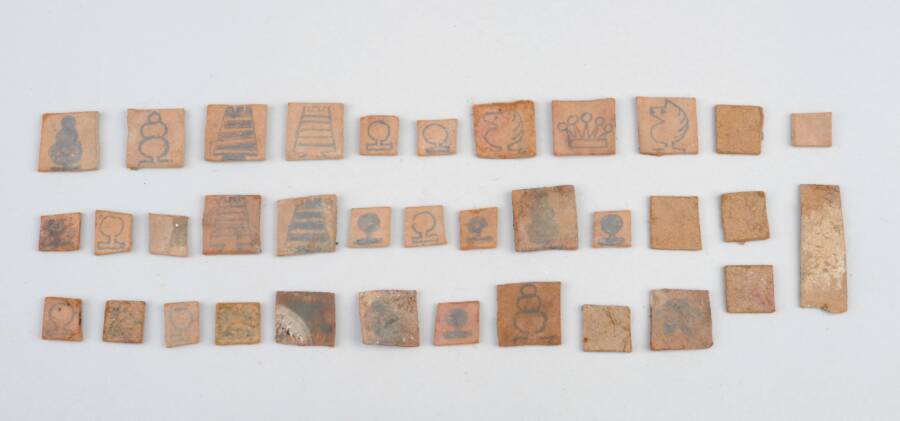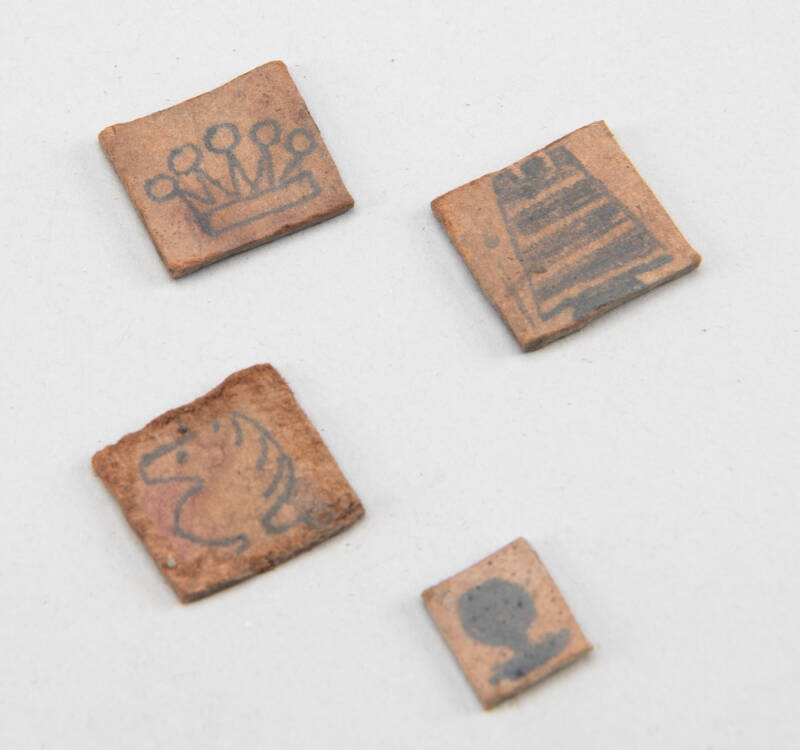Despite being 80 years old, the cardboard chess pieces were in shockingly good condition, offering new insight into the daily lives of Auschwitz prisoners.
Auschwitz-Birkenau Memorial and MuseumThe hand-drawn pieces were likely designed to be easy to hide.
Renovators at the Auschwitz-Birkenau Memorial and Museum recently discovered a haunting reminder of life at the former Auschwitz camp: a set of handmade chess pieces hidden beneath the floorboards. In all, they discovered 35 cardboard squares, on which icons were drawn to represent the pieces in a game of chess.
While the set is incomplete, museum curators feel the pieces will add a significant, touching layer to the museum’s collection.
The Cardboard Chess Pieces Found Under The Auschwitz Floor
The small, square cardboard pieces were found in Block 8 of the former concentration camp. The 35 pieces contained drawings of rooks, pawns, bishops, and knights, serving as a stark reminder of how prisoners attempted to maintain some sense of normalcy during the Holocaust.
In total, around 1.1 million people were killed at Auschwitz during the time of Nazi rule. Among those killed at the camp were Jews, Roma, Jehovah’s Witnesses, queer folk, and those with disabilities, all as a part of Adolf Hitler’s “final solution.”
“Several drawings may be a bit blurry, but the images of rooks, pawns, bishops, and knights are still easily distinguishable,” said Elżbieta Cajzer, head of the Museum’s Collections, in a press release. “Nevertheless, the set is incomplete, and some squares no longer have any traces of the drawing. Our evaluation shows that the objects are in good state of preservation. They will now be subjected to conservation treatment.”


Auschwitz-Birkenau Memorial and MuseumThe incomplete set of 35 handmade chess pieces.
Cajzer also emphasized that the pieces were likely not meant to be aesthetically pleasing but rather functional and, most importantly, easy to hide.
“The discovered chess pieces are unique in that they were crafted from prefabricated cardboard in a relatively primitive way,” she said. “We assume the focus was not on the aesthetic qualities but on functionality, easy portability, and quick concealment.”
The Chess Pieces Will Be On Display Alongside Other Prisoner Belongings
The museum also announced that a new exhibit is set to go on display in Block 8, meaning the chess pieces could be displayed in the area where they were found. The exhibit, entitled “Evening Time,” will focus on the short periods of theoretically free time prisoners had in the evening between roll call and curfew.
“We already have a wooden board and a pawn. They help one understand the overwhelming urge to escape the harsh reality of the camp,” said Magdalena Urbaniak of the New Main Exhibition team. “Prisoners tried to spend their free time playing various games, among other things. Chess and cards were popular games people could make themselves using illegally acquired pieces of cardboard or wood.”


Auschwitz-Birkenau Memorial and MuseumPrisoners used games like chess or cards to mentally escape their imprisonment.
One survivor of the camp, Jan Dziopek, was among those who secretly created chess pieces while working in the camp’s carpentry shop.
In an account shared by the museum, he said: “I had a lot of orders, even from SS men. However, I was reluctant to fulfill them. Nonetheless, I had to fulfill their orders because, under the guise of working for them, I could fulfill the requests of my colleagues, who paid me with rations of bread or camp soup… I won’t go into detail about the number of times and how many lashes I received for this.
“As I could not tinker in the warehouse for fear of getting caught, I created a secret hideout in the attic and transferred all the required tools from the warehouse. I tinkered there for hours.”
After reading about this chess set made by Auschwitz prisoners, learn about the work of Francesco Lotoro, the composer preserving the music created by Holocaust victims. Then, discover the story of Sobibór, the Nazi death camp where the prisoners fought back.
